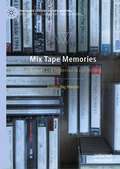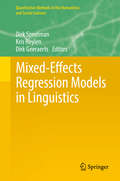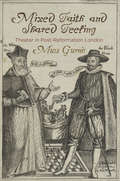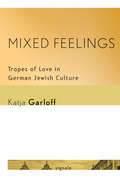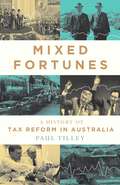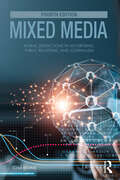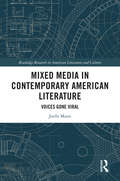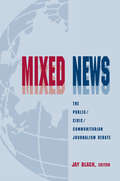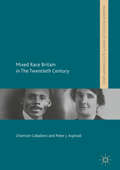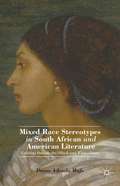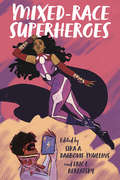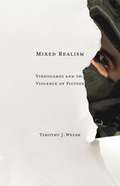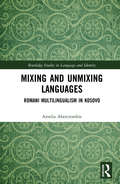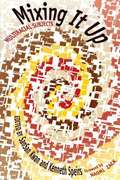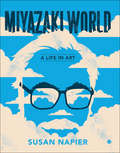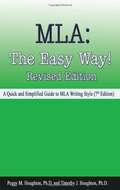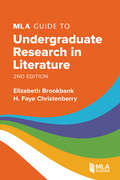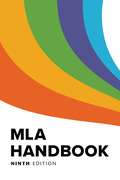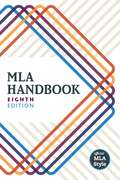- Table View
- List View
miVisión Lectura K [Unidad 3], Libro interactivo del estudiante
by María G. Arreguín-Anderson Richard GómezNIMAC-sourced textbook
miVisión Lectura K [Unidad 4] Libro interactivo del estudiante
by María G. Arreguín-Anderson Richard GómezNIMAC-sourced textbook
miVisión Lectura, K [Unidad 5] Libro interactivo del estudiante
by María G. Arreguín-Anderson Richard GómezNIMAC-sourced textbook
Mix Tape Memories: Movement and Difference in Life Writing (Palgrave Studies in Life Writing)
by Anders Høg HansenThis book ‘plays up’ stories of mostly unknown figures and their journeys through a life affected by movement, and a search for home. It engages with individuals and groups whose passions have carried the subjects through ‘uncharted’ or unhomely territories, here told in a series of ‘tracks’ depicting their roles in community memories and histories. Side A engages with individual journeys, such as Lewis, the American black literature book seller; the civil rights activist, Izzy, an American-Swedish folklorist; Eugene, a black classical pianist; and Pi, the Jew transported to Sweden during WWII. Side B focuses on communal histories and alternative educational and artistic spaces, addressing life writing and memory in German comic books; alternative educational spaces in Israel-Palestine and Africa, and ‘small press passions’ of zines/newsletter culture. Tellers and their interpreters are mediating identities where nationality, race, and class (and other markers of identity) have influenced selfhood and collective belonging - revealing how individuals and outsider cultures have the power to influence dominant cultures and inspire societal change.
Mixed Categories: The Morphosyntax of Noun Modification (Cambridge Studies in Linguistics #164)
by Irina Nikolaeva Andrew SpencerExploring the phenomenon of 'mixed categories', this book is the first in-depth study of the way in which languages can use a noun, as opposed to an adjective, to modify another noun. It investigates noun-adjective hybrids - adjectives and adjective-like attributive forms which have been derived from nouns and systematically retain certain nominal properties. These rarely-discussed types of mixed category raise a number of important theoretical questions about the nature of lexemic identity, the inflection-derivation divide, and more generally, the relationship between the structure of words and their phrasal syntax. The book proposes a new formal framework that models cross-linguistic and cross-constructional variation in noun modification constructions. The framework it offers enables readers to explicitly map word structure to syntactic structure, providing new insights into, and impacting upon, all current theoretical models of grammar.
Mixed-Effects Regression Models in Linguistics
by Dirk Speelman Kris Heylen Dirk GeeraertsWhen data consist of grouped observations or clusters, and there is a risk that measurements within the same group are not independent, group-specific random effects can be added to a regression model in order to account for such within-group associations. Regression models that contain such group-specific random effects are called mixed-effects regression models, or simply mixed models. Mixed models are a versatile tool that can handle both balanced and unbalanced datasets and that can also be applied when several layers of grouping are present in the data; these layers can either be nested or crossed. In linguistics, as in many other fields, the use of mixed models has gained ground rapidly over the last decade. This methodological evolution enables us to build more sophisticated and arguably more realistic models, but, due to its technical complexity, also introduces new challenges. This volume brings together a number of promising new evolutions in the use of mixed models in linguistics, but also addresses a number of common complications, misunderstandings, and pitfalls. Topics that are covered include the use of huge datasets, dealing with non-linear relations, issues of cross-validation, and issues of model selection and complex random structures. The volume features examples from various subfields in linguistics. The book also provides R code for a wide range of analyses.
Mixed Faith and Shared Feeling: Theater in Post-Reformation London
by Musa GurnisMixed Faith and Shared Feeling explores the mutually generative relationship between post-Reformation religious life and London's commercial theaters. It explores the dynamic exchange between the imaginatively transformative capacities of shared theatrical experience, with the particular ideological baggage that individual playgoers bring into the theater. While early modern English drama was shaped by the polyvocal, confessional scene in which it was embedded, Musa Gurnis contends that theater does not simply reflect culture but shapes it. According to Gurnis, shared theatrical experience allowed mixed-faith audiences to vicariously occupy alternative emotional and cognitive perspectives across the confessional spectrum.In looking at individual plays, such as Thomas Middleton's A Game of Chess and Shakespeare's Measure for Measure, Gurnis shows how theatrical process can restructure playgoers' experiences of confessional material and interrupt dominant habits of religious thought. She refutes any assumption that audiences consisted of conforming Church of England Protestants by tracking the complex and changing religious lives of seventy known playgoers. Arguing against work that seeks to draw fixed lines of religious affiliation around individual playwrights or companies, she highlights the common practice of cross-confessional collaboration among playhouse colleagues. Mixed Faith and Shared Feeling demonstrates how post-Reformation representational practices actively reshaped the ways ideologically diverse Londoners accessed the mixture of religious life across the spectrum of beliefs.
Mixed Feelings: Tropes of Love in German Jewish Culture (Signale: Modern German Letters, Cultures, and Thought)
by Katja GarloffSince the late eighteenth century, writers and thinkers have used the idea of love—often unrequited or impossible love—to comment on the changing cultural, social, and political position of Jews in the German-speaking countries. In Mixed Feelings, Katja Garloff asks what it means for literature (and philosophy) to use love between individuals as a metaphor for group relations. This question is of renewed interest today, when theorists of multiculturalism turn toward love in their search for new models of particularity and universality. Mixed Feelings is structured around two transformative moments in German Jewish culture and history that produced particularly rich clusters of interfaith love stories. Around 1800, literature promoted the rise of the Romantic love ideal and the shift from prearranged to love-based marriages. In the German-speaking countries, this change in the theory and practice of love coincided with the beginnings of Jewish emancipation, and both its supporters and opponents linked their arguments to tropes of love. Garloff explores the generative powers of such tropes in Moses Mendelssohn, G. E. Lessing, Friedrich Schlegel, Dorothea Veit, and Achim von Arnim. Around 1900, the rise of racial antisemitism had called into question the promises of emancipation and led to a crisis of German Jewish identity. At the same time, Jewish- Christian intermarriage prompted public debates that were tied up with racial discourses and concerns about procreation, heredity, and the mutability and immutability of the Jewish body. Garloff shows how modern German Jewish writers such as Arthur Schnitzler, Else Lasker-Schüler, and Franz Rosenzweig wrest the idea of love away from biologist thought and reinstate it as a model of sociopolitical relations. She concludes by tracing the relevance of this model in post-Holocaust works by Gershom Scholem, Hannah Arendt, and Barbara Honigmann.
Mixed Feelings: Tropes of Love in German Jewish Culture (Signale: Modern German Letters, Cultures, and Thought)
by Katja GarloffSince the late eighteenth century, writers and thinkers have used the idea of love—often unrequited or impossible love—to comment on the changing cultural, social, and political position of Jews in the German-speaking countries. In Mixed Feelings, Katja Garloff asks what it means for literature (and philosophy) to use love between individuals as a metaphor for group relations. This question is of renewed interest today, when theorists of multiculturalism turn toward love in their search for new models of particularity and universality. Mixed Feelings is structured around two transformative moments in German Jewish culture and history that produced particularly rich clusters of interfaith love stories. Around 1800, literature promoted the rise of the Romantic love ideal and the shift from prearranged to love-based marriages. In the German-speaking countries, this change in the theory and practice of love coincided with the beginnings of Jewish emancipation, and both its supporters and opponents linked their arguments to tropes of love. Garloff explores the generative powers of such tropes in Moses Mendelssohn, G. E. Lessing, Friedrich Schlegel, Dorothea Veit, and Achim von Arnim. Around 1900, the rise of racial antisemitism had called into question the promises of emancipation and led to a crisis of German Jewish identity. At the same time, Jewish- Christian intermarriage prompted public debates that were tied up with racial discourses and concerns about procreation, heredity, and the mutability and immutability of the Jewish body. Garloff shows how modern German Jewish writers such as Arthur Schnitzler, Else Lasker-Schüler, and Franz Rosenzweig wrest the idea of love away from biologist thought and reinstate it as a model of sociopolitical relations. She concludes by tracing the relevance of this model in post-Holocaust works by Gershom Scholem, Hannah Arendt, and Barbara Honigmann.
Mixed Fortunes: A History of Tax Reform in Australia
by Paul TilleyAustralia's history is sprinkled with attempts at tax reform - some successful, some not. Mixed Fortunes explores these efforts at substantive change in our tax system. Paul Tilley takes us from the establishment of the Australian Constitution at Federation in 1901 and the 1942 unification of income tax, through the seminal Asprey review in 1975 that set up the major tax reforms of the 1980s and 1990s, and up to the lack of tax reform, at both the Commonwealth and state levels, this century. Mixed Fortunes examines the roles of foundational reviews, which establish the case for reform, and determinative reviews, which implement reform. It assesses both the political economy issues of policymaking and the quality of the tax reforms that have been achieved in Australia. The key questions it addresses include: What makes a reform exercise work - or not? How do we assess the quality of Australia's tax reforms? And what lessons can be drawn from these experiences to help shape future tax reform exercises?
Mixed Media: Moral Distinctions in Advertising, Public Relations, and Journalism
by Tom Bivins Thomas BivinsMixed Media offers students of journalism, advertising, and public relations the tools for making ethical and moral decisions within their professional disciplines. The fourth edition of this popular text features more recent ethical theories that acknowledge and address intersectionality within the communicative landscape, including issues of gender, race, ability, and age. The author also takes into account today’s rapidly expanding technology, touching on subjects such as free speech, censorship, cancel culture, and misinformation, and considers how each of these is affected by online and social media. Other updates to the text include expanded coverage of citizen journalism, the increasing media use of artificial intelligence and virtual reality, power in communicative structures, and public interest, as well as refreshed examples throughout. As in previous editions of the book, special attention is paid to key ethical decision-making approaches and concerns in each media industry, including but not limited to truth telling, constituent obligations, persuasion versus advocacy, and respect for the consumers of public communication. Mixed Media is key reading for students of all branches of Media and Communication Ethics. The author's own website, featuring lecture notes, case studies and links to further reading, can be accessed at www.j397mediaethics.weebly.com.
Mixed Media in Contemporary American Literature: Voices Gone Viral (Routledge Research in American Literature and Culture)
by Joelle MannMixed Media in Contemporary American Literature: Voices Gone Viral investigates the formation and formulation of the contemporary novel through a historical analysis of voice studies and media studies. After situating research through voices of nineteenth- and twentieth-century American literature, this book examines the expressions of a multi-media vocality, examining the interactions among cultural polemics, aesthetic forms, and changing media in the twenty-first century. The novel studies shown here trace the ways in which the viral aesthetics of the contemporary novel move language out of context, recontextualizing human testimony by galvanizing mixed media forms that shape contemporary literature in our age of networks. Through readings of American authors such as Claudia Rankine, David Foster Wallace, Jennifer Egan, Junot Díaz, Michael Chabon, Joseph O’Neill, Michael Cunningham, and Colum McCann, the book considers how voice acts as a site where identities combine, conform, and are questioned relationally. By listening to and tracing the spoken and unspoken voices of the novel, the author identifies a politics of listening and speaking in our mediated, informational society.
Mixed News: The Public/civic/communitarian Journalism Debate (Routledge Communication Series)
by Jay BlackThis volume addresses some of the central issues of journalism today -- the nature and needs of the individual versus the nature and needs of the broader society; theories of communitarianism versus Enlightenment liberalism; independence versus interdependence (vs. co-dependency); negative versus positive freedoms; Constitutional mandates versus marketplace mandates; universal ethical issues versus situational and/or professional values; traditional values versus information age values; ethics of management versus ethics of worker bees; commitment and compassion versus detachment and professional "distance;" conflicts of interest versus conflicted disinterest; and "talking to" versus "talking with." All of these issues are discussed within the framework of the frenetic field of daily journalism--a field that operates at a pace and under a set of professional standards that all but preclude careful, systematic examinations of its own rituals and practices. The explorations presented here not only advance the enterprise, but also help student and professional observers to work through some of the most perplexing dilemmas to have faced the news media and public in recent times. This lively volume showcases the differing opinions of journalistic experts on this significant contemporary issue in public life. Unlike previous books and monographs which have tended toward unbridled enthusiasm about public journalism, and trade press articles which have tended toward pessimism, this book offers strong voices on several sides of this complex debate. To help inform the debate, a series of "voices"--journalistic interviews with practitioners and critics of public journalism -- is interspersed throughout the text. At the end of each essay, a series of quotes from a wide variety of sources -- "In other words..." -- augments each chapter with ideas and insights that support and contradict the points used by each chapter author.
Mixed Race Britain in The Twentieth Century (Palgrave Politics Of Identity And Citizenship)
by Chamion Caballero Peter J. AspinallThis book explores the overlooked history of racial mixing in Britain during the course of the twentieth century, a period in which there was considerable and influential public debate on the meanings and implications of intimately crossing racial boundaries. Based on research that formed the foundations of the British television series Mixed Britannia, the authors draw on a range of firsthand accounts and archival material to compare ‘official’ accounts of racial mixing and mixedness with those told by mixed race people, couples and families themselves. Mixed Race Britain in The Twentieth Century shows that alongside the more familiarly recognised experiences of social bigotry and racial prejudice there can also be glimpsed constant threads of tolerance, acceptance, inclusion and ‘ordinariness’. It presents a more complex and multifaceted history of mixed race Britain than is typically assumed, one that adds to the growing picture of the longstanding diversity and difference that is, and always has been, an ordinary and everyday feature of British life.
Mixed Race Stereotypes in South African and American Literature
by Diana Adesola MafeAmerica's new millennial interest in multiraciality coincides with South Africa's postapartheid push towards greater visibility as the Rainbow Nation. Here, Diana Adesola Mafe argues that the recent celebration of the mulatto as an avatar of positive change for multiracial nations like South Africa and the United States overlooks the complex global trajectories that resulted in this watershed moment. Mixed Race Stereotypes in South African and American Literature examines the popular literary stereotype, the tragic mulatto, from a comparative perspective. Mafe considers the ways in which specific South African and American writers have used this controversial literary character to challenge the logic of racial categorization. The result is a transnational dialogue between these respective national literatures, both of which use tragic mulatto fiction as a locus for broader questions about race and belonging.
Mixed-Race Superheroes
by Eric L. Berlatsky Gregory T. Carter Chris Gavaler Chris Koenig-Woodyard Nicholas E. Miller Isabel Molina-Guzman Jorge J. Santos Kwasu David Tembo Sika A. Dagbovie-Mullins Corrine Esther Collins Jasmine Mitchell Adrienne ReshaAmerican culture has long represented mixed-race identity in paradoxical terms. On the one hand, it has been associated with weakness, abnormality, impurity, transgression, shame, and various pathologies; however, it can also connote genetic superiority, exceptional beauty, and special potentiality. This ambivalence has found its way into superhero media, which runs the gamut from Ant-Man and the Wasp’s tragic mulatta villain Ghost to the cinematic depiction of Aquaman as a heroic “half-breed.” The essays in this collection contend with the multitude of ways that racial mixedness has been presented in superhero comics, films, television, and literature. They explore how superhero media positions mixed-race characters within a genre that has historically privileged racial purity and propagated images of white supremacy. The book considers such iconic heroes as Superman, Spider-Man, and The Hulk, alongside such lesser-studied characters as Valkyrie, Dr. Fate, and Steven Universe. Examining both literal and symbolic representations of racial mixing, this study interrogates how we might challenge and rewrite stereotypical narratives about mixed-race identity, both in superhero media and beyond.
Mixed Realism: Videogames and the Violence of Fiction (Electronic Mediations #50)
by Timothy J. WelshMixed Realism is about how we interact with media. Timothy J. Welsh shows how videogames, like novels, both promise and trouble experiences of &“immersion.&” His innovative methodology offers a new understanding of the expanding role of virtuality in contemporary life. Today&’s wired culture is a mixed reality, conducted as exchanges between virtual and material contexts. We make balance transfers at an ATM, update Facebook timelines, and squeeze in sessions of Angry Birds on the subway. However, the &“virtual&” is still frequently figured as imaginary, as opposed to &“real.&” The vision of 1990s writers of a future that would pit virtual reality against actual reality has never materialized, yet it continues to haunt cultural criticism. Our ongoing anxiety about immersive media now surrounds videogames, especially &“shooter games,&” and manifests as a fear that gamers might not know the difference between the virtual world and the real world.As Welsh notes, this is the paradox of real virtuality. We understand that the media-generated virtualities that fill our lives are not what they represent. But what are they if they are not real? Do they have presence, significance, or influence exceeding their material presence and the user processes that invoke them? What relationships do they establish through and beyond our interactions with them?Mixed Realism brims with fresh analyses of literary works such as Truman Capote&’s In Cold Blood and Mark Z. Danielewski&’s House of Leaves, along with sustained readings of controversial videogames such as Super Columbine Massacre and Call of Duty: Modern Warfare 2. Continually connecting the dots between surprising groupings of texts and thinkers, from David Foster Wallace to the cult-classic videogame Eternal Darkness and from Cormac McCarthy to Grand Theft Auto, it offers a fresh perspective on both digital games and contemporary literature.
Mixing and Unmixing Languages: Romani Multilingualism in Kosovo (Routledge Studies in Language and Identity)
by Amelia AbercrombieMixing and Unmixing Languages uses the politics and practices of language to understand social hierarchies and social change in a post-conflict and post-socialist context. The book focuses on Roma in Prizren, Kosovo, where the author conducted long-term ethnographic fieldwork, using language learning as a central method. Shifts in language practices among this highly multilingual group have reflected the demise of Yugoslav socialism, the rise of ethno-nationalist politics and conflict, and the post-war reversal of power relations in Kosovo. Roma in Prizren nostalgically narrate a past of cosmopolitanism and employment in contrast to the present. Their position today is complex: while they stress their relative integration, this position is fragile in the face of nationalist politics and imported neoliberal economic policies. Within this context, Roma NGO workers have found an economic niche working on projects to protect multiculturalism and minorities, funded by international aid agencies, centred on Romani language. This book discusses the historical trajectory and current configurations of a Romani organisation in the town, the standardisation of Romani and the hierarchical organisation of linguistic forms and language learning, the self-representation of Roma and the ‘gypsy’ image through Romani-language drama, and attitudes to purism, mixing and cosmopolitanism. Mixing and Unmixing Languages is suitable for academics and students in the areas of linguistic anthropology and linguistic ethnography, Romani studies, South-East European studies and sociolinguistics.
Mixing It Up: Multiracial Subjects
by Sansan Kwan Kenneth SpeirsThe United States Census 2000 presents a twenty-first century America in which mixed-race marriages, cross-race adoption, and multiracial families in general are challenging the ethnic definitions by which the nation has historically categorized its population. Addressing a wide spectrum of questions raised by this rich new cultural landscape, Mixing It Up brings together the observations of ten noted voices who have experienced multiracialism first-hand.<P><P>From Naomi Zack's "American Mixed Race: The United States 2000 Census and Related Issues" to Cathy Irwin and Sean Metzger's "Keeping Up Appearances: Ethnic Alien-Nation in Female Solo Performance," this diverse collection spans the realities of multiculturalism in compelling new analysis. Arguing that society's discomfort with multiracialism has been institutionalized throughout history, whether through the "one drop" rule or media depictions, SanSan Kwan and Kenneth Speirs reflect on the means by which the monoracial lens is slowly being replaced.
Miyazakiworld: A Life in Art
by Susan NapierThe story of filmmaker Hayao Miyazaki's life and work, including his significant impact on Japan and the world A thirtieth†‘century toxic jungle, a bathhouse for tired gods, a red†‘haired fish girl, and a furry woodland spirit—what do these have in common? They all spring from the mind of Hayao Miyazaki, one of the greatest living animators, known worldwide for films such as My Neighbor Totoro, Princess Mononoke, Spirited Away, Howl’s Moving Castle, and The Wind Rises. Japanese culture and animation scholar Susan Napier explores the life and art of this extraordinary Japanese filmmaker to provide a definitive account of his oeuvre. Napier insightfully illuminates the multiple themes crisscrossing his work, from empowered women to environmental nightmares to utopian dreams, creating an unforgettable portrait of a man whose art challenged Hollywood dominance and ushered in a new chapter of global popular culture.
MLA: The Easy Way! Revised Edition 2009
by Peggy M. Houghton Timothy J. HoughtonMLA: The Easy Way! presents the basics of MLA style in a clear, concise, accurate, and easy-to-navigate package.
MLA Guide to Undergraduate Research in Literature (MLA GUIDES)
by Elizabeth Brookbank H. Faye ChristenberryWhat makes a good research topic in a literature class? What does your professor mean by "peer-reviewed" sources? What should you do if you can't find enough material? This approachable guide walks students through the process of research in literary studies, providing them with tools for responding successfully to course assignments.Written by two experienced librarians, the guide introduces the resources available through college and university libraries and explains how to access the ones a student needs. It focuses on research in literature, identifying relevant databases and research guides and explaining different types of sources and the role each plays in researching and writing about a literary text. But it also contains helpful information for any student researcher, describing strategies for searching the web to find the most useful material and offering guidance on organizing research and documenting sources with MLA style.Extensively updated and revised, the second edition emphasizes digital resources that can be accessed remotely, offers critical thinking strategies for evaluating sources, and includes more information on writing about audiovisual as well as written works.This book contains an introduction and the chapters "Starting the Research Process," "Searching Your Library Discovery System or Catalog," "Searching Subject-Specific Databases," "Searching the Internet," "Finding Reviews," "Using Contextual Primary Sources," "Finding Background Information," "Managing Sources and Creating Your Bibliography," and "Guides to Research in Literature Written in English" as well as a bibliography of sources for studying literature in English and a glossary of terms.
MLA Handbook (MLA Handbook)
by The Modern Language Association of AmericaThe ninth edition works as both a textbook and a reference guide. Focusing on source evaluation, it features a wealth of visual examples and updated advice on punctuation and grammar, footnotes and endnotes, annotated bibliographies, and paper formatting. An all-in-one resource that makes MLA style easier to learn and use, the MLA Handbook includes: Expanded, in-depth guidance on creating works-cited-list entries using the MLA template of core elements that explains what each core element is, where to find it in various sources, and how to style it. A new, easy-to-follow explanation of in-text citations. A new chapter containing recommendations for using inclusive language. A new appendix with hundreds of sample works-cited-list entries by publication format, including books, databases, websites, YouTube videos, interviews, and more. Updated guidelines on avoiding plagiarism.
MLA Handbook
by The Modern Language Association of AmericaThe Modern Language Association, the authority on research and writing, takes a fresh look at documenting sources in the eighth edition of the MLA Handbook, the official guide to MLA format. Works are published today in a dizzying variety of ways: a novel, for example, may be read in print, online, or as an e-book--or perhaps listened to as an audiobook. Writers of research papers routinely need to know how to cite works on Web sites, videos on platforms like YouTube, interviews and other works created by multiple authors, journal articles contained in databases, online images, posts on social media sites, song lyrics, and more. Instead of providing separate instructions for each format, the MLA's unique, innovative approach recommends one set of guidelines that writers can apply to any type of source.This groundbreaking edition of the MLA's best-selling handbook is short and designed for easy use. It guides writers through the principles behind evaluating sources for their research and thus focuses on the key skills of information and digital literacy. It then shows writers how to cite sources in their writing, offering detailed guidance on in-text citations, quoting and paraphrasing, avoiding plagiarism, and more. Intended for students, teachers, librarians, and advanced scholars, the handbook is an indispensable resource in composition, communication, literature, language arts, film, media studies, digital humanities, and related fields.
MLA Handbook, 8th Edition
by The Modern Language Association of AmericaThe Modern Language Association, the authority on research and writing, takes a fresh look at documenting sources in the eighth edition of the MLA Handbook. Works are published today in a dizzying range of formats. A book, for example, may be read in print, online, or as an e-book--or perhaps listened to in an audio version. On the Web, modes of publication are regularly invented, combined, and modified. Previous editions of the MLA Handbook provided separate instructions for each format, and additional instructions were required for new formats. In this groundbreaking new edition of its best-selling handbook, the MLA recommends instead one universal set of guidelines, which writers can apply to any type of source. Shorter and redesigned for easy use, the eighth edition of the MLA Handbook guides writers through the principles behind evaluating sources for their research. It then shows them how to cite sources in their writing and create useful entries for the works-cited list. More than just a new edition, this is a new MLA style.

